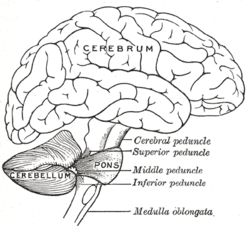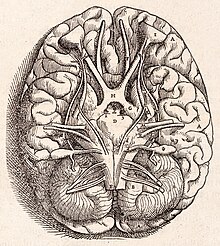This article needs more reliable medical references for verification or relies too heavily on primary sources. (June 2015) |  |
| Cerebellum | |
|---|---|
 A human brain, with the cerebellum colored in purple | |
 Drawing of the human brain, showing cerebellum and pons | |
| Details | |
| Part of | Metencephalon |
| Artery | SCA, AICA, PICA |
| Vein | superior, inferior |
| Identifiers | |
| NeuroLex ID | birnlex_1489 |
| Anatomical terms of neuroanatomy | |
Dyschronometria, also called dyschronia, is a condition of cerebellar dysfunction in which an individual cannot accurately estimate the amount of time that has passed (i.e., distorted time perception). It is associated with cerebellar ataxia,[1][2] when the cerebellum has been damaged and does not function to its fullest ability. Lesions to the cerebellum can cause dyssynergia, dysmetria, dysdiadochokinesia, dysarthria, and ataxia of stance and gait.[3] Dyschronometria can result from autosomal dominant cerebellar ataxia (ADCA).[4]

- ^ Lagarde, J.; Hajjioui, A.; Yelnik, A. (2009). "Neuropsychological disorders induced by cerebellar damage". Annals of Physical and Rehabilitation Medicine. 52 (4): 360–370. doi:10.1016/j.rehab.2009.02.002. PMID 19874739.
- ^ Ferrarin, M; Gironi, M; Mendozzi, L; Nemni, R; Mazzoleni, P; Rabuffetti, M (2005). "Procedure for the quantitative evaluation of motor disturbances in cerebellar ataxic patients". Med. Biol. Eng. Comput. 43 (3): 349–356. doi:10.1007/BF02345812. PMID 16035223. S2CID 1307431.
- ^ Diener, HC; Dichgans, J (1992). "Pathophysiology of Cerebellar Ataxia". Movement Disorders. 7 (2): 95–109. doi:10.1002/mds.870070202. PMID 1584245. S2CID 19100385.
- ^ Whaley, N.R.; Fujioka, S.; Wszolek, Z.K. (2011). "Autosomal dominant cerebellar ataxia type I: A review of the phenotypic and genotypic characteristics". Orphanet Journal of Rare Diseases. 6: 33. doi:10.1186/1750-1172-6-33. PMC 3123548. PMID 21619691.